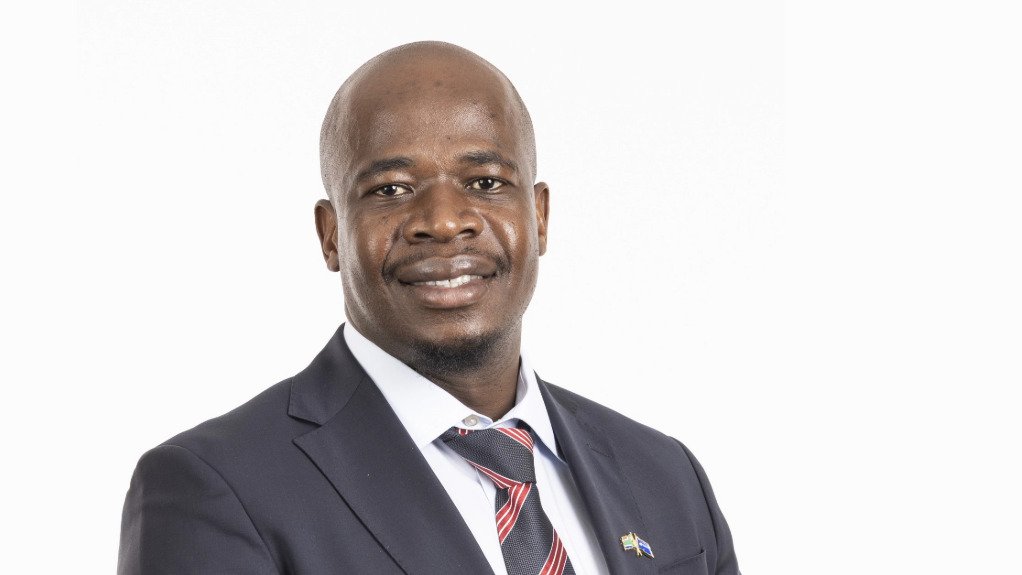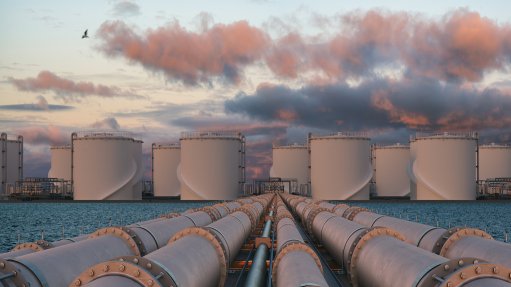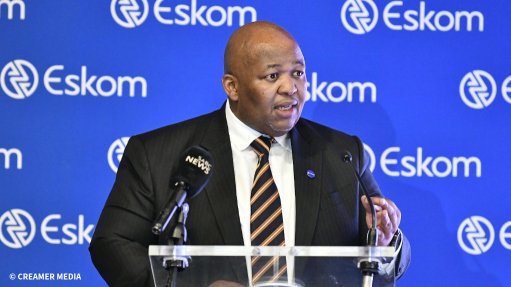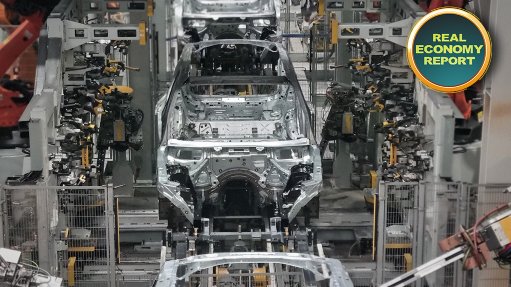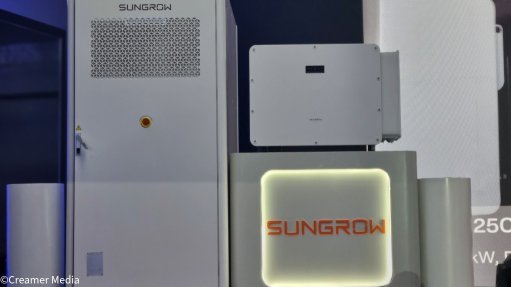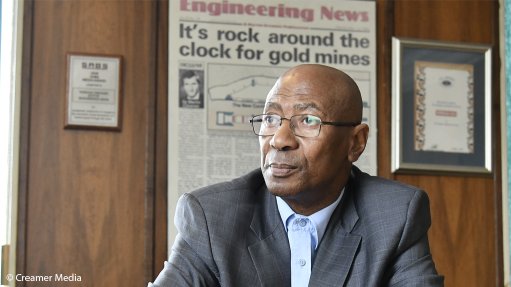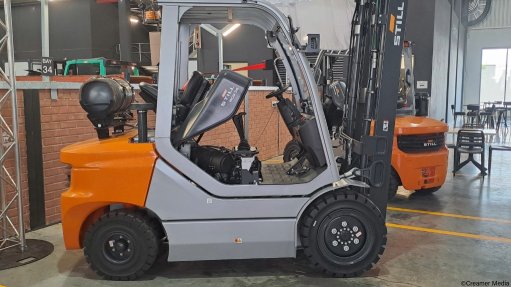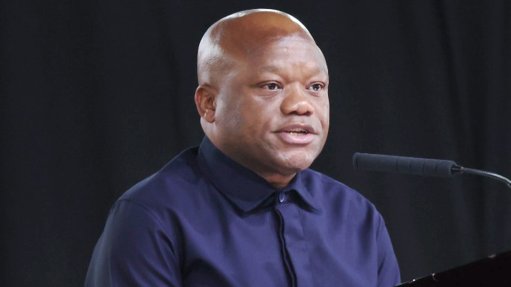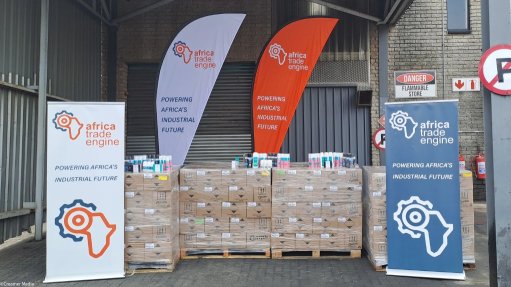Partnership framework being prioritised ahead of Eskom Green launch
Eskom group executive for renewables Rivoningo Mnisi reports that the State-owned company has received a positive response to a tender for companies to support it with the establishment of a standalone renewables business known as ‘Eskom Green’.
Eskom released a tender invitation in April seeking firms with proven credentials in establishing renewable-energy businesses to assist it with the creation of the new unit.
Mnisi tells Engineering News that there were more than ten respondents to the tender and that it hopes to be in a position to select the preferred advisory partner by the end of September.
This advisory consortium will include technical, legal and governance specialists and will not be a permanent feature of Eskom Green, but will assist only with its pre-launch structuring.
In finalising the structure, Eskom and its advisers will draw on international experiences where conventional utilities, some of which are also State owned, have established sizeable renewables businesses.
Mnisi tells Engineering News that Eskom Green’s eventual structure is likely to reflect a blend of the models that have been deployed in the North American, European and Asian markets.
As part of its just energy transition strategy, Eskom has identified an immediate 5 GW pipeline of so-called ‘repowering projects’ that could ultimately be brought under the Eskom Green umbrella.
Eskom is initially targeting to develop these new facilities on land in close proximity to its existing power stations and grid infrastructure.
Both are seen as drawcards for potential partners, particularly in light of the current difficulties in securing new grid connections, and the scarcity of transmission infrastructure in provinces with high-yield solar and wind resources.
However, the group has also set an aspiration for the development of 32 GW of renewables by 2040, which would involve the construction of assets on non-Eskom land.
Once founded, the standalone business intends entering into non-exclusive partnerships with independent power producers (IPPs) to build a portfolio of solar, wind, battery, pumped hydro and green hydrogen assets under the Eskom Green banner.
The utility has given itself a two-year lead time for the launch of Eskom Green, which means that some of the repowering projects could proceed ahead of its establishment, but Mnisi is optimistic that the entity will be operational by the end of 2026.
REPOWERING PORTFOLIO
The initial repowering projects are located at five coal power stations (Hendrina, Grootvlei, Arnot, Camden and Kriel) scheduled for retirement by 2030, as well as at Komati, which was retired in 2022.
Eskom’s repowering portfolio includes 122 MW of solar PV capacity at Komati, alongside a 150 MW battery energy storage system (BESS); 800 MW of solar PV at Arnot, alongside 200 MW of BESS and 168 MW of wind; 680 MW of solar PV at Camden; 587 MW of solar PV at Hendrina; and 800 MW of solar PV at Kriel, together with 200 MW of BESS and 1 000 MW of gas to power.
Some of these projects, or parts thereof, may proceed ahead of Eskom Green’s launch, but Mnisi says they could be progressively brought under its banner once it is established.
For instance, contracts for a 72 MW solar PV plant and 150 MW BESS facility at Komati are likely to be awarded before the end of 2025, while Eskom Green may also not be established in time to align with Eskom’s goal of having 2 GW of renewables projects under way by 2026.
Meanwhile, Eskom Generation, which is still to be fully vertically separated, will house the State-owned enterprise’s coal power stations, as well as any new gas-to-power projects that could be implemented by Eskom.
Mnisi reports that work is under way to progress the repowering projects to “bankability”, including by securing all environmental authorisations and finalising the wind and solar measurements and front-end engineering required by banks and private investors.
Eskom is also in the market for transaction advisers to assist it in meeting the “bankability standards” required for attracting investors to the projects.
Mnisi insists that this preparatory work is confirming the competitiveness of the projects, when benchmarked with renewables projects that have been procured from IPPs under government’s public procurement bidding rounds.
This pre-construction work is being funded internally, but Eskom will require the approval of the National Treasury to proceed to construction, most immediately because of a moratorium placed on it raising new debt as part of the R230-billion debt-relief package under which it is still trading.
However, partnerships will also be required to close the funding gaps left by Eskom’s weak balance sheet and to unlock certain development finance that is conditional on private participation.
PARTNERSHIP FRAMEWORK
Private participation is, for example, a requirement should Eskom wish to access the $2.6-billion in concessional finance approved for South Africa by the Climate Investment Funds, which is backed by six multilateral development banks.
Much priority attention is, thus, being given to the finalisation of a public-private partnership (PPP) framework, which Eskom and Eskom Green hope to employ to enter into partnerships with IPPs.
Mnisi confirms that the framework has yet to be approved by the National Treasury and tells Engineering News that there are ongoing consultations on the matter in a bid to have the framework finalised by the end of the year.
“We have done the internal work on the PPP framework, and we are currently setting up workshops with the National Treasury to seek their input, guidance and approval.
“I don't think there's any misalignment and the focus currently is on finding a solution that will ensure that Eskom Green is able to be agile and is able to deliver projects at speed and also cost competitively,” he tells Engineering News.
He is also optimistic that IPPs will find the Eskom Green value proposition compelling, reporting that it receives regular approaches from IPPs regarding possible partnership agreements.
Another key milestone for Eskom’s repowering and broader renewables ambitions will be the updated Integrated Resource Plan, which will outline the allocations for various generation technologies to be procured over the coming few decades.
Should there be no specific allocation for the repowering projects, Eskom will need to apply for a Ministerial determination exempting the projects from the IRP.
However, Mnisi is optimistic that the updated IRP will cater for the utility’s immediate renewables and BESS pipeline.
“We believe Eskom Green can make a positive contribution to South Africa's electricity industry, and I am optimistic that we will be in a position to launch the standalone company next year,” he concludes.
Article Enquiry
Email Article
Save Article
Feedback
To advertise email advertising@creamermedia.co.za or click here
Comments
Press Office
Announcements
What's On
Subscribe to improve your user experience...
Option 1 (equivalent of R125 a month):
Receive a weekly copy of Creamer Media's Engineering News & Mining Weekly magazine
(print copy for those in South Africa and e-magazine for those outside of South Africa)
Receive daily email newsletters
Access to full search results
Access archive of magazine back copies
Access to Projects in Progress
Access to ONE Research Report of your choice in PDF format
Option 2 (equivalent of R375 a month):
All benefits from Option 1
PLUS
Access to Creamer Media's Research Channel Africa for ALL Research Reports, in PDF format, on various industrial and mining sectors
including Electricity; Water; Energy Transition; Hydrogen; Roads, Rail and Ports; Coal; Gold; Platinum; Battery Metals; etc.
Already a subscriber?
Forgotten your password?
Receive weekly copy of Creamer Media's Engineering News & Mining Weekly magazine (print copy for those in South Africa and e-magazine for those outside of South Africa)
➕
Recieve daily email newsletters
➕
Access to full search results
➕
Access archive of magazine back copies
➕
Access to Projects in Progress
➕
Access to ONE Research Report of your choice in PDF format
RESEARCH CHANNEL AFRICA
R4500 (equivalent of R375 a month)
SUBSCRIBEAll benefits from Option 1
➕
Access to Creamer Media's Research Channel Africa for ALL Research Reports on various industrial and mining sectors, in PDF format, including on:
Electricity
➕
Water
➕
Energy Transition
➕
Hydrogen
➕
Roads, Rail and Ports
➕
Coal
➕
Gold
➕
Platinum
➕
Battery Metals
➕
etc.
Receive all benefits from Option 1 or Option 2 delivered to numerous people at your company
➕
Multiple User names and Passwords for simultaneous log-ins
➕
Intranet integration access to all in your organisation



